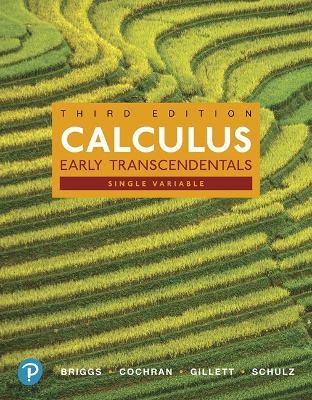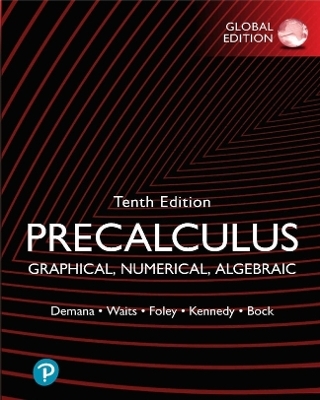
Single Variable Calculus
Pearson
978-0-13-499671-4 (ISBN)
- Titel z.Zt. nicht lieferbar
- Versandkostenfrei innerhalb Deutschlands
- Auch auf Rechnung
- Verfügbarkeit in der Filiale vor Ort prüfen
- Artikel merken
Used books, rentals, and purchases made outside of Pearson
If purchasing or renting from companies other than Pearson, the access codes for the MyLab platform may not be included, may be incorrect, or may be previously redeemed. Check with the seller before completing your purchase.
For 3- to 4-semester courses covering single-variable and multivariable calculus, taken by students of mathematics, engineering, natural sciences, or economics.
This package includes MyLab Math.
The most successful new calculus text in the last two decades
The much-anticipated 3rd Edition of Briggs’ Calculus Series retains its hallmark features while introducing important advances and refinements. Briggs, Cochran, Gillett, and Schulz build from a foundation of meticulously crafted exercise sets, then draw students into the narrative through writing that reflects the voice of the instructor. Examples are stepped out and thoughtfully annotated, and figures are designed to teach rather than simply supplement the narrative. The groundbreaking eBook contains approximately 700 Interactive Figures that can be manipulated to shed light on key concepts.
For the 3rd Edition, the authors synthesized feedback on the text and MyLab™ Math content from over 140 instructors and an Engineering Review Panel. This thorough and extensive review process, paired with the authors’ own teaching experiences, helped create a text that was designed for today’s calculus instructors and students.
Reach every student by pairing this text with MyLab Math
MyLab Math is the teaching and learning platform that empowers instructors to reach every student. By combining trusted author content with digital tools and a flexible platform, MyLab Math personalizes the learning experience and improves results for each student.
0134996712 / 9780134996714 Single Variable Calculus: Early Transcendentals and MyLab Math with Pearson eText - Title-Specific Access Card Package, 3/e Package consists of:
0134766857 / 9780134766850 Calculus: Early Transcendentals, Single Variable
0134856929 / 9780134856926 MyLab Math with Pearson eText - Standalone Access Card - for Calculus: Early Transcendentals, Single Variable
William Briggs has been on the mathematics faculty at the University of Colorado at Denver for twenty-three years. He received his BA in mathematics from the University of Colorado and his MS and PhD in applied mathematics from Harvard University. He teaches undergraduate and graduate courses throughout the mathematics curriculum with a special interest in mathematical modeling and differential equations as it applies to problems in the biosciences. He has written a quantitative reasoning textbook, Using and Understanding Mathematics; an undergraduate problem solving book, Ants, Bikes, and Clocks; and two tutorial monographs, The Multigrid Tutorial and The DFT: An Owner’s Manual for the Discrete Fourier Transform. He is the Society for Industrial and Applied Mathematics (SIAM) Vice President for Education, a University of Colorado President’s Teaching Scholar, a recipient of the Outstanding Teacher Award of the Rocky Mountain Section of the Mathematical Association of America (MAA), and the recipient of a Fulbright Fellowship to Ireland. Lyle Cochran is a professor of mathematics at Whitworth University in Spokane, Washington. He holds BS degrees in mathematics and mathematics education from Oregon State University and a MS and PhD in mathematics from Washington State University. He has taught a wide variety of undergraduate mathematics courses at Washington State University, Fresno Pacific University, and, since 1995, at Whitworth University. His expertise is in mathematical analysis, and he has a special interest in the integration of technology and mathematics education. He has written technology materials for leading calculus and linear algebra textbooks including the Instructor’s Mathematica Manual for Linear Algebra and Its Applications by David C. Lay and the Mathematica Technology Resource Manual for Thomas’ Calculus. He is a member of the MAA and a former chair of the Department of Mathematics and Computer Science at Whitworth University. Bernard Gillett is a Senior Instructor at the University of Colorado at Boulder; his primary focus is undergraduate education. He has taught a wide variety of mathematics courses over a twenty-year career, receiving five teaching awards in that time. Bernard authored a software package for algebra, trigonometry, and precalculus; the Student’s Guide and Solutions Manual and the Instructor’s Guide and Solutions Manual for Using and Understanding Mathematics by Briggs and Bennett; and the Instructor’s Resource Guide and Test Bank for Calculus and Calculus: Early Transcendentals by Briggs, Cochran, and Gillett. Bernard is also an avid rock climber and has published four climbing guides for the mountains in and surrounding Rocky Mountain National Park. Eric Schulz has been teaching mathematics at Walla Walla Community College since 1989 and began his work with Mathematica in 1992. He has an undergraduate degree in mathematics from Seattle Pacific University and a graduate degree in mathematics from the University of Washington. Eric loves working with students and is passionate about their success. His interest in innovative and effective uses of technology in teaching mathematics has remained strong throughout his career. He is the developer of the Basic Math Assistant, Classroom Assistant, and Writing Assistant palettes that ship in Mathematica worldwide. He is an author on multiple textbooks: Calculus and Calculus: Early Transcendentals with Briggs, Cochran, Gillett, and Precalculus with Sachs, Briggs — where he writes, codes, and creates dynamic eTexts combining narrative, videos, and Interactive Figures using Mathematica and CDF technology.
1. Functions
1.1 Review of Functions
1.2 Representing Functions
1.3 Inverse, Exponential, and Logarithmic Functions
1.4 Trigonometric Functions and Their Inverses
Review Exercises
2. Limits
2.1 The Idea of Limits
2.2 Definitions of Limits
2.3 Techniques for Computing Limits
2.4 Infinite Limits
2.5 Limits at Infinity
2.6 Continuity
2.7 Precise Definitions of Limits
Review Exercises
3. Derivatives
3.1 Introducing the Derivative
3.2 The Derivative as a Function
3.3 Rules of Differentiation
3.4 The Product and Quotient Rules
3.5 Derivatives of Trigonometric Functions
3.6 Derivatives as Rates of Change
3.7 The Chain Rule
3.8 Implicit Differentiation
3.9 Derivatives of Logarithmic and Exponential Functions
3.10 Derivatives of Inverse Trigonometric Functions
3.11 Related Rates
Review Exercises
4. Applications of the Derivative
4.1 Maxima and Minima
4.2 Mean Value Theorem
4.3 What Derivatives Tell Us
4.4 Graphing Functions
4.5 Optimization Problems
4.6 Linear Approximation and Differentials
4.7 L'Hôpital's Rule
4.8 Newton's Method
4.9 Antiderivatives
Review Exercises
5. Integration
5.1 Approximating Areas under Curves
5.2 Definite Integrals
5.3 Fundamental Theorem of Calculus
5.4 Working with Integrals
5.5 Substitution Rule
Review Exercises
6. Applications of Integration
6.1 Velocity and Net Change
6.2 Regions Between Curves
6.3 Volume by Slicing
6.4 Volume by Shells
6.5 Length of Curves
6.6 Surface Area
6.7 Physical Applications
Review Exercises
7. Logarithmic, Exponential, and Hyperbolic Functions
7.1 Logarithmic and Exponential Functions Revisited
7.2 Exponential Models
7.3 Hyperbolic Functions
Review Exercises
8. Integration Techniques
8.1 Basic Approaches
8.2 Integration by Parts
8.3 Trigonometric Integrals
8.4 Trigonometric Substitutions
8.5 Partial Fractions
8.6 Integration Strategies
8.7 Other Methods of Integration
8.8 Numerical Integration
8.9 Improper Integrals
Review Exercises
9. Differential Equations
9.1 Basic Ideas
9.2 Direction Fields and Euler's Method
9.3 Separable Differential Equations
9.4 Special First-Order Linear Differential Equations
9.5 Modeling with Differential Equations
Review Exercises
10. Sequences and Infinite Series
10.1 An Overview
10.2 Sequences
10.3 Infinite Series
10.4 The Divergence and Integral Tests
10.5 Comparison Tests
10.6 Alternating Series
10.7 The Ratio and Root Tests
10.8 Choosing a Convergence Test
Review Exercises
11. Power Series
11.1 Approximating Functions with Polynomials
11.2 Properties of Power Series
11.3 Taylor Series
11.4 Working with Taylor Series
Review Exercises
12. Parametric and Polar Curves
12.1 Parametric Equations
12.2 Polar Coordinates
12.3 Calculus in Polar Coordinates
12.4 Conic Sections
Review Exercises
13. Vectors and the Geometry of Space
13.1 Vectors in the Plane
13.2 Vectors in Three Dimensions
13.3 Dot Products
13.4 Cross Products
13.5 Lines and Planes in Space
13.6 Cylinders and Quadric Surfaces
Review Exercises
14. Vector-Valued Functions
14.1 Vector-Valued Functions
14.2 Calculus of Vector-Valued Functions
14.3 Motion in Space
14.4 Length of Curves
14.5 Curvature and Normal Vectors
Review Exercises
15. Functions of Several Variables
15.1 Graphs and Level Curves
15.2 Limits and Continuity
15.3 Partial Derivatives
15.4 The Chain Rule
15.5 Directional Derivatives and the Gradient
15.6 Tangent Planes and Linear Approximation
15.7 Maximum/Minimum Problems
15.8 Lagrange Multipliers
Review Exercises
16. Multiple Integration
16.1 Double Integrals over Rectangular Regions
16.2 Double Integrals over General Regions
16.3 Double Integrals in Polar Coordinates
16.4 Triple Integrals
16.5 Triple Integrals in Cylindrical and Spherical Coordinates
16.6 Integrals for Mass Calculations
16.7 Change of Variables in Multiple Integrals
Review Exercises
17. Vector Calculus
17.1 Vector Fields
17.2 Line Integrals
17.3 Conservative Vector Fields
17.4 Green's Theorem
17.5 Divergence and Curl
17.6 Surface Integrals
17.7 Stokes' Theorem
17.8 Divergence Theorem
Review Exercises
D2 Second-Order Differential Equations ONLINE
D2.1 Basic Ideas
D2.2 Linear Homogeneous Equations
D2.3 Linear Nonhomogeneous Equations
D2.4 Applications
D2.5 Complex Forcing Functions
Review Exercises
Appendices
Proofs of Selected Theorems
Algebra Review ONLINE
Complex Numbers ONLINE
Answers Index Table of Integrals
| Erscheint lt. Verlag | 8.4.2018 |
|---|---|
| Sprache | englisch |
| Maße | 216 x 277 mm |
| Gewicht | 1678 g |
| Themenwelt | Mathematik / Informatik ► Mathematik |
| ISBN-10 | 0-13-499671-2 / 0134996712 |
| ISBN-13 | 978-0-13-499671-4 / 9780134996714 |
| Zustand | Neuware |
| Informationen gemäß Produktsicherheitsverordnung (GPSR) | |
| Haben Sie eine Frage zum Produkt? |
aus dem Bereich
